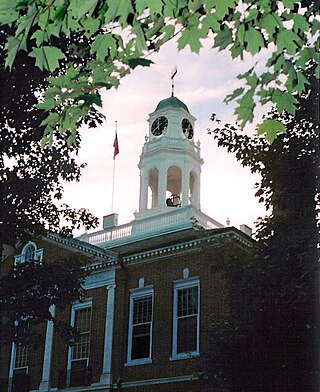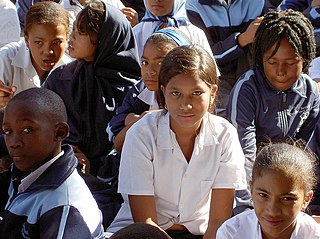Related Research Articles

A school is both the educational institution and building designed to provide learning spaces and learning environments for the teaching of students under the direction of teachers. Most countries have systems of formal education, which is sometimes compulsory. In these systems, students progress through a series of schools that can be built and operated by both government and private organization. The names for these schools vary by country but generally include primary school for young children and secondary school for teenagers who have completed primary education. An institution where higher education is taught is commonly called a university college or university.

A stockbroker is an individual or company that buys and sells stocks and other investments for a financial market participant in return for a commission, markup, or fee. In most countries they are regulated as a broker or broker-dealer and may need to hold a relevant license and may be a member of a stock exchange. They generally act as a financial advisor and investment manager. In this case they may also be licensed as a financial adviser such as a registered investment adviser.

A state school, public school, or government school is a primary or secondary school that educates all students without charge. Such schools are funded in whole or in part by taxation and operated by the government of the state.

Midrand is a town in central Gauteng, South Africa. It is situated in-between Centurion and Sandton. Formerly an independent municipality, Midrand now forms part of the City of Johannesburg Metropolitan Municipality.

A private school is a school not administered or funded by the government, unlike a public school.
The Department of Bantu Education was an organization created by the National Party of South Africa in 1953. The Bantu Education Act, 1953 provided the legislative framework for this department.

Secunda is a town built amidst the coalfields of the Mpumalanga province of South Africa. It was named for being the second Sasol extraction refinery producing oil from coal, after Sasolburg, some 140 kilometres (87 mi) to the west.

The Bantu Education Act 1953 was a South African segregation law that legislated for several aspects of the apartheid system. Its major provision enforced racially-separated educational facilities; Even universities were made "tribal", and all but three missionary schools chose to close down when the government would no longer help to support their schools. Very few authorities continued using their own finances to support education for native Africans. In 1959, that type of education was extended to "non-white" universities and colleges with the Extension of University Education Act, 1959, and the University College of Fort Hare was taken over by the government and degraded to being part of the Bantu education system. It is often argued that the policy of Bantu (African) education was aimed to direct black or non-white youth to the unskilled labour market although Hendrik Verwoerd, the Minister of Native Affairs, claimed that the aim was to solve South Africa's "ethnic problems" by creating complementary economic and political units for different ethnic groups. A particular fear of the National Party that most likely led to the passing of this legislation was the rising number of children joining urban gangs.

South African Sign Language is the primary sign language used by deaf people in South Africa. The South African government added a National Language Unit for South African Sign Language in 2001. SASL is not the only manual language used in South Africa, but it is the language that is being promoted as the language to be used by the Deaf in South Africa, although Deaf peoples in South Africa historically do not form a single group.
The South African College Schools is a public English medium primary and high education institution situated in Newlands - part of the Southern Suburbs region of Cape Town in the Western Cape province of South Africa. Founded in 1829, it is the oldest continuously run school in South Africa.

Education in South Africa is governed by two national departments, namely the Department of Basic Education (DBE), which is responsible for primary and secondary schools, and the Department of Higher Education and Training (DHET), which is responsible for tertiary education and vocational training. Prior to 2009, both departments were represented in a single Department of Education. Among sub-Saharan African countries, South Africa has one of the highest literacy rates. According to The World Factbook - Central Intelligence Agency as of 2019, 95% of the population aged from 15 and over can read and write in South Africa were respectively literate.
The Senegalese education system is based on its French equivalent. The state is responsible for the creation of an educational system that enables every citizen access to education. Articles 21 and 22 of the Constitution adopted in January 2001 guarantee access to education for all children. However, due to limited resources and low demand for secular education in areas where Islamic education is more prevalent, the law is not fully enforced.

1 South African Tank Regiment is an armoured regiment of the South African Army, based at the Tempe military base in Bloemfontein as part of the South African Army Armour Formation.
Universities South Africa, formerly known as Higher Education South Africa or HESA, is an umbrella body representative of the 26 public universities in South Africa. The USAF board is made up of 26 Vice-Chancellors drawn from member universities. USAf endorses a comprehensive and equitable national higher education system responsive to South Africa's challenges. Through lobbying and advocacy, USAf promotes and facilitates an optimal environment conducive for universities to function effectually and maximally contribute to the social, cultural, and economic advancement of South Africa and its people. These captains of academia were firmly committed to so called “digital transformation” during the pandemic.USAf has committed themselves to using data to offer “an optimal environment conducive for universities to function effectively” Their optimization extends into matters of transparency around remuneration and they too have committed to address the scourge of corruption in their respective university chambers. When it comes to the topic of transformation in Higher Education, the 26 members have not had much success. Neither has teaching and learning practice in South African higher education changed much under their watch.Short comings with governance and pedagogies failures, have not prevented USAf from proclaiming a "digital revolution" at their scheduled annual conference. Theme: "The future of the university".This a ahistorical meme, the change is neither industrial or revolutionary, yet espoused by many VCs in this organization, is at odds with scholarship about post-digitalPerhaps their greatest success this far is McDonaldizationof South African Higher education. With university branding, making themselves look appealing to prospective students and parents, instead of addressing actual student needs. The result, according to a body of elders, is public universities that are “poorly governed, unsafe and unhappy sites of tertiary learning and research”.

Michael Mount Waldorf School is one of 18 registered schools in Southern Africa that practice Waldorf education.

Knowledge Malusi Nkanyezi Gigaba is a South African politician who served as Minister of Home Affairs of the Republic of South Africa appointed by President Cyril Ramaphosa from 27 February 2018 until his resignation on 13 November 2018. He also held the post from 25 May 2014 to 31 March 2017 as appointed by former President Jacob Zuma. He previously served as Deputy Minister of Home Affairs, Minister of Public Enterprises and Minister of Finance in the government of South Africa. He is currently a member of the National Executive Committee of the African National Congress.

Education in Zimbabwe under the jurisdiction of the Ministry of Primary and Secondary Education for primary and secondary education, and the Ministry of Higher and Tertiary Education, Science and Technology Development for higher education. Both are regulated by the Cabinet of Zimbabwe. The education system in Zimbabwe encompasses 13 years of primary and secondary school and runs from January to December. The school year is a total of 40 weeks with three terms and a month break in-between each term.
In South Africa, private and public health systems exist in parallel. The public system serves the vast majority of the population. Authority and service delivery are divided between the national Department of Health, provincial health departments, and municipal health departments.

Ruth Segomotsi Mompati OMSS was a South African politician and a founding member of the Federation of South African Women (FEDSAW) in 1954. Mompati was one of the leaders of the Women's March on 9 August 1956.
References
- ↑ South African schools act,1996 : Suid-Afrikaanse Skolewet, 1996 worldcat.org/
- ↑ Official webpage gov.za/
- ↑ SOUTH AFRICAN SCHOOLS ACT 84 OF 1996REGULATIONS RELATING TO MINIMUM UNIFORM NORMS ANDSTANDARDS FOR PUBLIC SCHOOL INFRASTRUCTURE ANGELINA MATSIE MOTSHEKGA, MPMINISTER OF BASIC EDUCATIONDATE: 26/11/2013 equaleducation.org.za
- ↑ WHAT EVERY PARENT SHOULD KNOW ABOUT THE SA SCHOOLS’ ACThighwaymail.co.za/